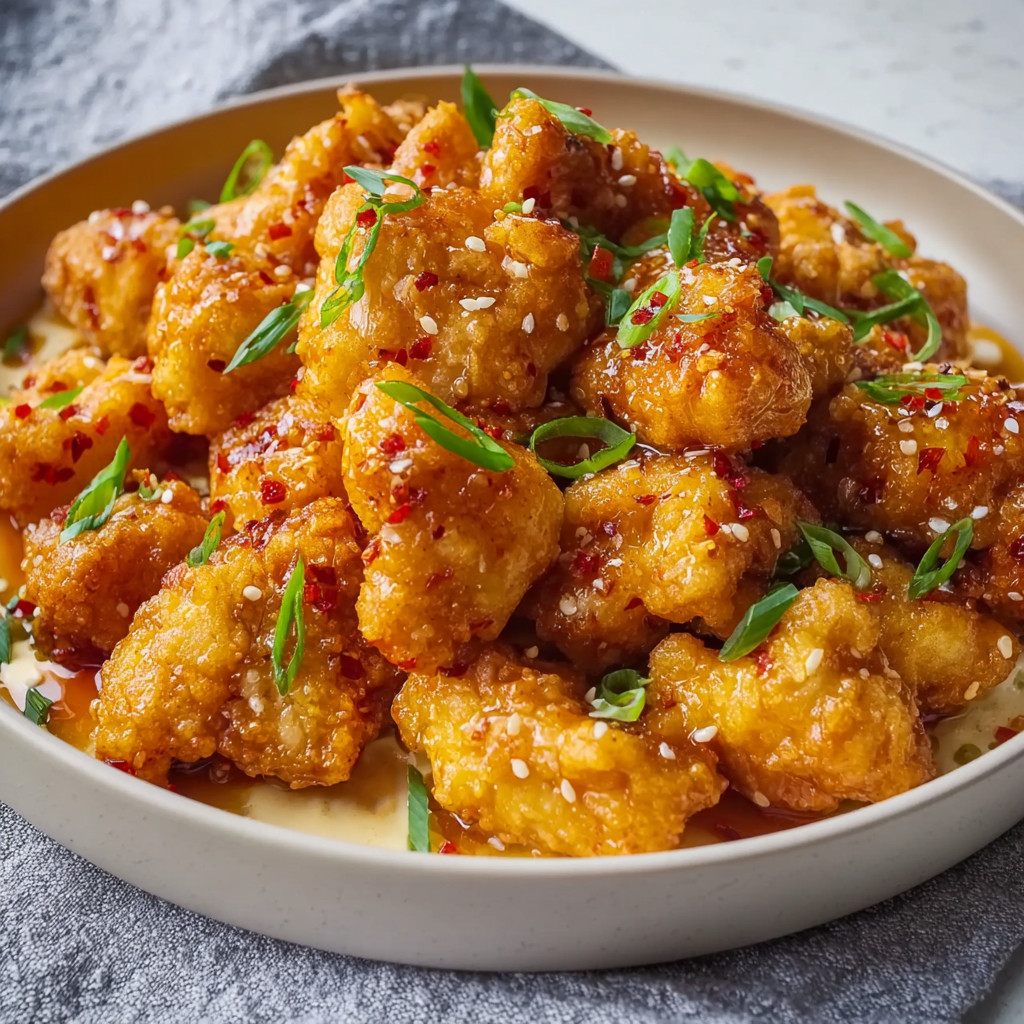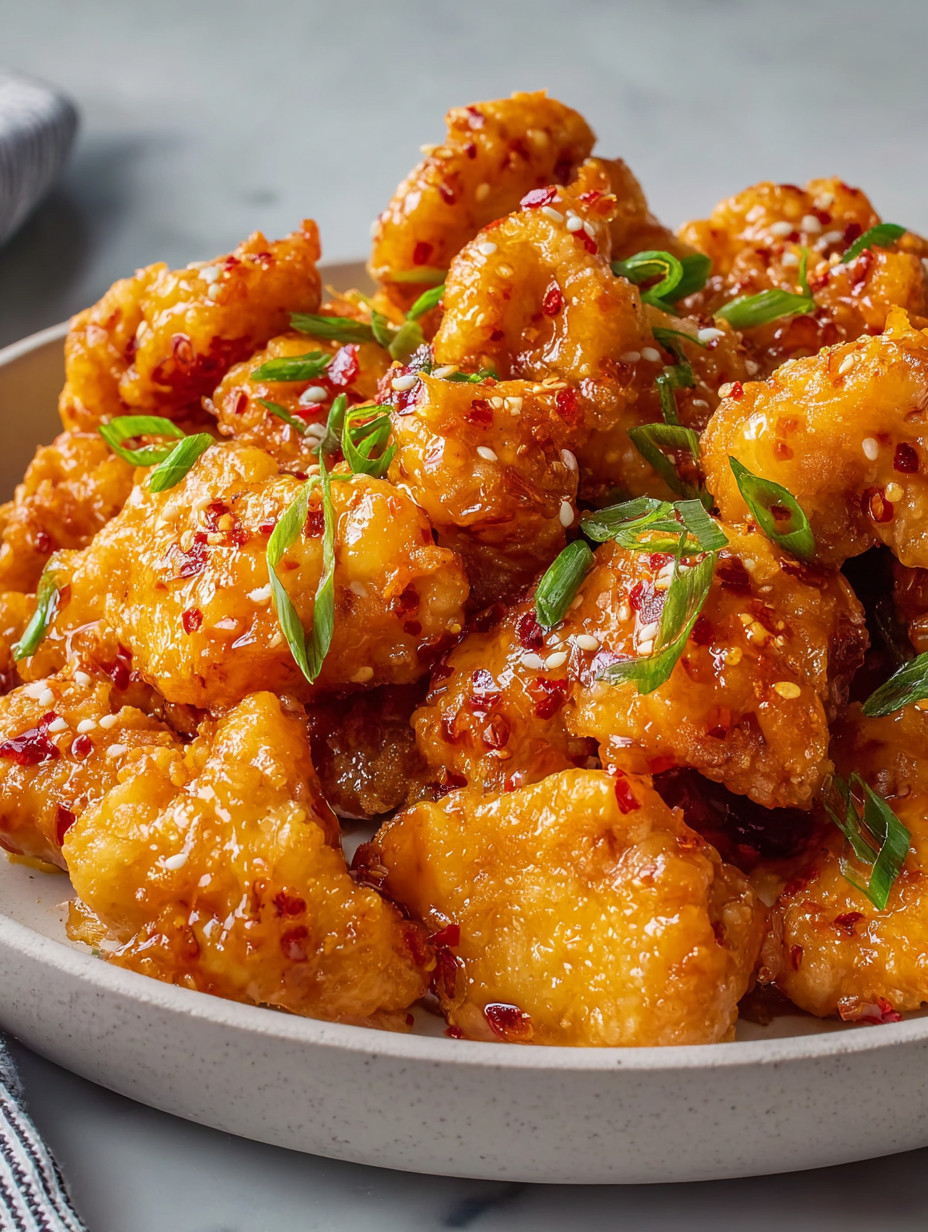 Pin
Pin
Crispy saucy bang bang chicken always brings a little excitement to dinnertime thanks to its double-fried texture and bold creamy sauce. I sought out this dish after loving it at a neighborhood restaurant and was determined to get that shatteringly crisp coating at home. The secret is the two-step frying and the sweet-spicy velvety sauce that clings to every bite.
I still remember my family’s faces the first time I served this at home. My kids actually cheered when they crunched into the chicken drenched in sauce then insisted I make it again the next week.
Ingredients
- Milk: brings moisture and tenderizes the chicken opt for whole for a richer flavor
- Large egg: adds richness and helps the coating stick look for bright orange yolks for freshness
- Chicken breasts: make for juicy bites select similar-sized pieces so all cook evenly
- Potato starch: helps develop an extra crisp crust seek out fine pure white powder with no lumps
- All-purpose flour: adds body and structure use fresh flour for best results
- Salt: wakes up all the seasonings choose fine sea salt for even coverage
- Ground black pepper: gives subtle heat grind fresh for the best aroma
- Shichimi togarashi: infuses a peppery punch any quality ground red pepper works as a swap
- Frying oil: neutral oil like vegetable or peanut ensures a clean taste opt for oil with a high smoke point
- Mayonnaise: creates the creamy base for sauce choose full-fat or Japanese-style if available
- Honey: balances the heat with natural sweetness real honey always delivers the best flavor
- Sweet chili sauce: adds the signature tangy heat look for one with visible chili flecks
- Gochujang: brings a deep savory heat use the classic spicy variety for best depth
Step-by-Step Instructions
- Marinate the Chicken
- Whisk the milk and a large egg together in a spacious bowl until smooth and creamy. Add in your chicken pieces making sure they are fully coated. Allow them to soak for fifteen minutes so every bite is extra tender and absorbs flavor. After marinating thoroughly drain and gently discard the excess egg mixture so the chicken is moist but not soggy.
- Coat the Chicken
- In a separate bowl handful by handful mix together the potato starch all-purpose flour salt pepper and shichimi. Transfer this dry mix to a large plastic bag then add the marinated chicken pieces. Seal the bag with as little air as possible and shake with energy so every cube is dusted all over with the seasoned starch mix.
- First Fry
- Pour enough oil into a deep saucepan so it reaches about two inches up the side then heat over medium until it shimmers and a thermometer reads three twenty five degrees Fahrenheit. Fry the chicken in small batches without crowding for about ninety seconds each batch. You want the coating set but not browned. Lift out the pieces using a slotted spoon and drain them on a paper towel. Give each batch its own space so they do not steam.
- Second Fry
- Once all chicken has finished its first dip turn up the oil heat to three fifty degrees Fahrenheit briskly boiling. Return the first batch of chicken back into the hot oil in small amounts frying for another minute and a half. Look for a deep golden shell and a lively sizzle. Remove with care back to a new towel so the extra oil wicks away.
- Mix the Sauce
- In a roomy bowl stir together mayonnaise honey sweet chili sauce and gochujang until silky and completely combined. Taste and adjust for your perfect level of sweetness and heat now is the time.
- Coat the Chicken
- Quickly toss the freshly fried chicken bites into the sauce gently so every piece is coated in glossy luscious spicy sauce.
- Serve
- Pile the finished bang bang chicken into a serving bowl and scatter with fresh green scallions if you fancy. Eat while the coating still crackles for the best experience.
 Pin
Pin
My favorite element is truly the sauce. Watching those golden chicken bites turn glossy with sweet and spicy flavor always reminds me of the laughter at our last family party. Even my picky sister-in-law finished her serving and asked for seconds.
Storage tips
Allow leftovers to cool fully then store in an airtight container in the fridge for up to three days. Reheat in a hot oven or air fryer to restore maximum crispness and do not microwave as it will soften the coating. Extra sauce can be stored separately and tossed just before serving for best results.
Ingredient substitutions
If you cannot find potato starch cornstarch works for a similar crunch though the texture will be slightly different. No shichimi Use a pinch of cayenne or crushed red pepper for heat. Any hot sauce can replace gochujang though you will lose a bit of that unique depth so add a little smoked paprika if you like.
Serving suggestions
Bang bang chicken shines as an appetizer with toothpicks or as a main dish over steamed rice. Sometimes I scatter toasted sesame seeds and sliced cucumbers on top for a refreshing contrast. A side of crisp lettuce or cabbage slaw cools the spicy flavors perfectly.
 Pin
Pin
Cultural context
While inspired by a famous Sichuan dish this Americanized version skips traditional Sichuan peppercorns in favor of crowd-pleasing sweet heat. The double fry method and creamy spicy sauce are nods to the Asian American takeout classics many of us love to recreate at home.
Recipe FAQs
- → Why is the chicken fried twice in this method?
Frying the chicken twice helps create an extra crispy crust by first cooking the meat through at a lower temperature, then crisping the exterior at a higher temperature.
- → Can I substitute potato starch with another coating?
Cornstarch can be used as an alternative; however, potato starch offers a silkier texture and neutral flavor, enhancing crispiness.
- → What gives the sauce its signature balance of flavors?
The sauce combines mayonnaise for creaminess, honey for sweetness, sweet chili sauce for mild heat, and gochujang for an earthy, spicy depth.
- → How can I adjust the spice level in this dish?
Adjust the amount of shichimi togarashi and gochujang to your preference or substitute with milder or hotter peppers to control heat.
- → Is a splatter screen necessary when frying?
Using a splatter screen can help keep your stovetop clean and prevent oil from splashing, improving safety during frying.
